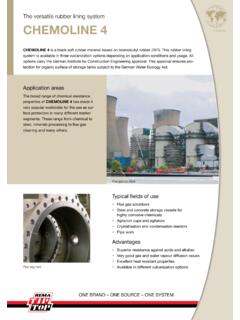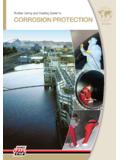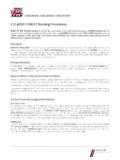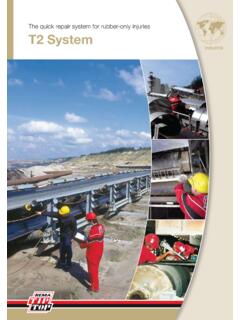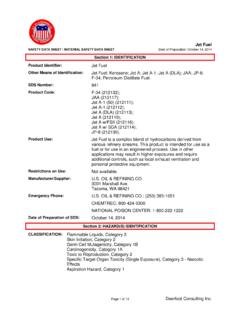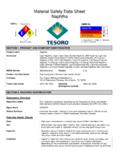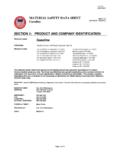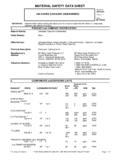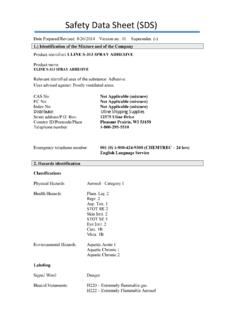Transcription of Safety Data Sheet - REMA TIP TOP
1 Safety data Sheet REMA TIP TOP Product #s: SC4000-QT, SC4000-GAL, SC4000-DRUM SDS #: RTT-IND-004 Rev. # 5 Rev. Date: 1/13/2017 Page 1 of 11 SDS ID: RTT-IND-004 1. CHEMICAL PRODUCT AND COMPANY IDENTIFICATION Product Name: SC-4000 CEMENT Chemical Family: Ester & Aromatic Hydrocarbon Solution Product Use: Adhesive Restrictions on Use: Use as directed by manufacturer Manufacturer: Rema Tip Top - North America 119 Rockland Ave. Northvale, NJ 07647 Phone: 201 256-8200 24-Hour Emergency Phone Number: North America: 800-424-9300 (CHEMTREC) International: 703-527-3887 (CHEMTREC) Collect Calls Accepted 2.
2 HAZARD IDENTIFICATION GHS Classifications Health Hazards Skin Irritation, Category 2 Eye Irritation, Category 2A Specific Target Organ Systemic Toxicity, Single Exposure, Category 3, Central Nervous System [Inhalation] Aspiration Hazard, Category 1 Physical Hazards Flammable Liquid, Category 2 Environmental Hazards Chronic Aquatic Toxicity, Category 1 GHS-Labeling Pictograms: Signal Word: Danger! Safety data Sheet REMA TIP TOP Product #s: SC4000-QT, SC4000-GAL, SC4000-DRUM SDS #: RTT-IND-004 Rev. # 5 Rev. Date: 1/13/2017 Page 2 of 11 SDS ID: RTT-IND-004 Hazard Statements H225: Highly flammable liquid and vapor H304: May be fatal if swallowed and enters airways H315: Causes skin irritation H319: Causes serious eye irritation H336: May cause drowsiness or dizziness H410: Very toxic to aquatic life with long lasting effects Precautionary Statements Prevention: P210: Keep away from heat/sparks/open flames/hot surfaces.
3 No smoking. P233: Keep container tightly closed. P235: Keep cool. P240: Ground/bond container and receiving equipment. P241: Use explosion-proof electrical/ventilating/lighting/equipmen t. P242: Use only non-sparking tools. P243: Take precautionary measures against static discharge. P260: Do not breathe vapors. P264: Wash skin and exposed areas thoroughly after handling. P271: Use only outdoors or in a well-ventilated area. P273: Avoid release to the environment. P280: Wear protective gloves/protective clothing/eye protection/face protection. Response: P301 + P310 + P331: IF SWALLOWED: Immediately call a POISON CENTER or doctor/physician. Do NOT induce vomiting. P302 + P352: IF ON SKIN: Wash with plenty of soap and water.
4 P303 + P361 + P353: IF ON SKIN: Remove immediately all contaminated clothing. Rinse skin with water/shower. P332 + P313: If skin irritation occurs: Get medical advice/attention. P304 + P340 + P314: IF INHALED: Remove victim to fresh air and keep at rest in a position comfortable for breathing. Get medical advice/attention if you feel unwell. P305 + P351 + P338: IF IN EYES: Rinse cautiously with water for several minutes. Remove contact lenses, if present and easy to do. Continue rinsing. P337 + P313: If eye irritation persists: Get medical advice/attention. P370 + P378: In case of fire: Use alcohol-resistant foam, carbon dioxide, or dry chemical for extinction. P391: Collect spillage. Storage: P403 + P233 + P235: Store in a well-ventilated place.
5 Keep container tightly closed. Keep cool. P405: Store locked up Disposal: P501: Dispose of contents/container in accordance with local, regional, and federal regulations Safety data Sheet REMA TIP TOP Product #s: SC4000-QT, SC4000-GAL, SC4000-DRUM SDS #: RTT-IND-004 Rev. # 5 Rev. Date: 1/13/2017 Page 3 of 11 SDS ID: RTT-IND-004 3. COMPOSITION/ INFORMATION ON INGREDIENTS Chemical characterization Ester & Aromatic Hydrocarbon Solution Component* CAS # % By Wt. Cyclohexane 110-82-7 25 - 40 Ethyl Acetate 141-78-6 25 - 40 Zinc Oxide 1314-13-2 1 - 5 *The above listed components are OSHA hazardous materials which contribute to this products GHS Hazard Categorization as prescribed in OSHA s Hazard Communication 29 CFR 4.
6 FIRST AID MEASURES Inhalation Symptoms & Effects: Stomach or intestinal irritation, nausea, vomiting, diarrhea, nose and throat irritation, dizziness, drowsiness, weakness, fatigue, nausea, headache, unconsciousness Measures: Immediately remove victim to fresh air and keep at rest in a position comfortable for breathing. If breathing has stopped, begin artificial respiration. If breathing is difficult, administer oxygen. Seek immediate medical attention. Skin Contact Symptoms & Effects: Skin irritation, burning sensation, dry skin, skin cracking, other skin damage Measures: Immediately wash skin with plenty of water for at least 15 minutes. Remove contaminated clothing and shoes while washing.
7 Wash contaminated clothing before reuse. If skin irritation persists, seek medical attention. Eye Contact Symptoms & Effects: Eye irritation, stinging, tearing, redness, eye swelling Measures: Immediately rinse eyes with water for at least 15 minutes. Remove contact lenses after the initial few minutes and if easy to do so and resume rinsing. Rinse beneath eyelids by holding eyelids apart with clean fingers while rinsing. Seek immediate medical attention. Ingestion Symptoms & Effects: Stomach or intestinal irritation, nausea, vomiting, diarrhea, nose and throat irritation, dizziness, drowsiness, weakness, fatigue, nausea, headache, and unconsciousness. Since this material is an aspiration hazard, swallowing may result in lung inflammation and other lung injuries.
8 Measures: Seek immediate medical attention. Do NOT induce vomiting. If the victim is drowsy or unconscious, do not give anything by mouth. Do not give milk. Place individual on their left side and place their head down. Do not leave victim unattended. Safety data Sheet REMA TIP TOP Product #s: SC4000-QT, SC4000-GAL, SC4000-DRUM SDS #: RTT-IND-004 Rev. # 5 Rev. Date: 1/13/2017 Page 4 of 11 SDS ID: RTT-IND-004 5. FIRE FIGHTING MEASURES Suitable Extinguishing Media: Alcohol-resistant foam, Carbon dioxide, Dry chemical Unsuitable Extinguishing Media: Water stream/jet Hazardous Combustion Products: Carbon monoxide, Carbon dioxide Protective Equipment for Fire-Fighters: Wear full firefighting turn-out gear (full Bunker gear), and respiratory protection (SCBA).
9 Precautions for Fire-Fighters: Water stream may be ineffective for extinguishment unless used under favorable conditions. This product is volatile and readily gives off flammable vapors which may travel along the ground or be moved by ventilation. Do not allow run-off from firefighting to enter drains or water courses. Use water spray to cool fully closed containers. Avoid spreading burning liquid with water used for cooling purposes. 6. ACCIDENTAL RELEASE MEASURES Protective Equipment: Recommended to wear NIOSH approved respiratory apparatus, chemical splash goggles & resistant gloves and discard of gloves that show tears, pinholes, or signs of wear. Wear proper garments to prevent skin exposure, such as long-sleeves and pants.
10 Personal Precautions: Persons not wearing proper PPE should be excluded from the area of contamination until clean-up has been completed. Ensure adequate ventilation. Eliminate all ignition sources and pay attention to the spreading of gases, especially at ground level. Environmental Precautions: Do not allow discharge into drains, surface waters, or sanitary sewer system. Prevent spreading over a wide area by constructing a dike or using oil barriers. Local authorities should be advised if significant spillages cannot be contained or if material discharges into drains or ground water. Methods & Materials for Clean-Up: Immediately evacuate the spilled area and provide maximum ventilation.
